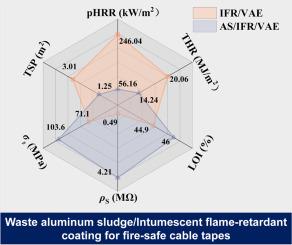Extraordinary roles of waste aluminum sludge in enhancing flame retardancy, smoke suppression and electric insulation of intumescent flame-retardant coating for reliable cable tapes
IF 7.4
2区 化学
Q1 POLYMER SCIENCE
引用次数: 0
Abstract
Enhancing the flame retardancy of cable tape coatings while maintaining low electrical conductivity during fire incidents remains a significant challenge. In this study, we address this issue by incorporating waste aluminum sludge (AS) into an intumescent flame retardant (IFR)/vinyl acetate–ethylene (VAE) coatings, thus optimizing the flame retardancy, mechanical properties, and electrical insulation of fiberglass tapes. AS, composed of boehmite and bayerite phases with a sheet-like structure, interacts chemically with IFR/VAE during combustion, yielding thermally stable minerals (Al(PO3)3 and AlPO4). Concurrently, its layered morphology promotes the formation of a compact and well-ordered carbonaceous char. The resulting hybrid mineral/carbon char acts as a robust physical barrier, effectively impeding heat and mass transfer, while disrupting the conductive carbon network. This dual mechanism leads to a remarkable enhancement in fire safety and electrical insulation performance, including: a 77.2 % reduction in peak heat release rate, a 29.0 % decrease in total heat release, a 58.5 % suppression in total smoke production, a 759.2 % increase in surface resistivity, a 45.7 % improvement in tensile strength, and a 2.4 % rise in limiting oxygen index. This work not only presents a sustainable strategy for upcycling industrial waste into high-performance flame retardants but also elucidates the mechanistic role of aluminum oxides/hydroxides in modifying the combustion behavior of IFR systems.

废铝污泥在提高可靠电缆带膨胀型阻燃涂料的阻燃性、抑烟性和电绝缘性方面的特殊作用
提高电缆带涂层的阻燃性,同时在火灾事故中保持低导电性仍然是一个重大挑战。在本研究中,我们通过将废铝污泥(AS)掺入膨胀阻燃(IFR)/醋酸乙烯-乙烯(VAE)涂层中来解决这一问题,从而优化了玻璃纤维胶带的阻燃性、机械性能和电绝缘性。AS由薄铝石相和贝汞相组成,呈片状结构,在燃烧过程中与IFR/VAE发生化学反应,生成热稳定的矿物Al(PO3)3和AlPO4。同时,其层状形态促进了致密有序碳质炭的形成。由此产生的混合矿物/碳炭作为一个强大的物理屏障,有效地阻碍了传热和传质,同时破坏了导电碳网络。这种双重机制显著提高了防火安全性和电气绝缘性能,包括:峰值放热率降低77.2%,总放热率降低29.0%,总产烟量降低58.5%,表面电阻率提高759.2%,抗拉强度提高45.7%,极限氧指数提高2.4%。这项工作不仅提出了将工业废物升级为高性能阻燃剂的可持续策略,而且阐明了氧化铝/氢氧化物在改变IFR系统燃烧行为中的机制作用。
本文章由计算机程序翻译,如有差异,请以英文原文为准。
求助全文
约1分钟内获得全文
求助全文
来源期刊

Polymer Degradation and Stability
化学-高分子科学
CiteScore
10.10
自引率
10.20%
发文量
325
审稿时长
23 days
期刊介绍:
Polymer Degradation and Stability deals with the degradation reactions and their control which are a major preoccupation of practitioners of the many and diverse aspects of modern polymer technology.
Deteriorative reactions occur during processing, when polymers are subjected to heat, oxygen and mechanical stress, and during the useful life of the materials when oxygen and sunlight are the most important degradative agencies. In more specialised applications, degradation may be induced by high energy radiation, ozone, atmospheric pollutants, mechanical stress, biological action, hydrolysis and many other influences. The mechanisms of these reactions and stabilisation processes must be understood if the technology and application of polymers are to continue to advance. The reporting of investigations of this kind is therefore a major function of this journal.
However there are also new developments in polymer technology in which degradation processes find positive applications. For example, photodegradable plastics are now available, the recycling of polymeric products will become increasingly important, degradation and combustion studies are involved in the definition of the fire hazards which are associated with polymeric materials and the microelectronics industry is vitally dependent upon polymer degradation in the manufacture of its circuitry. Polymer properties may also be improved by processes like curing and grafting, the chemistry of which can be closely related to that which causes physical deterioration in other circumstances.
 求助内容:
求助内容: 应助结果提醒方式:
应助结果提醒方式:


